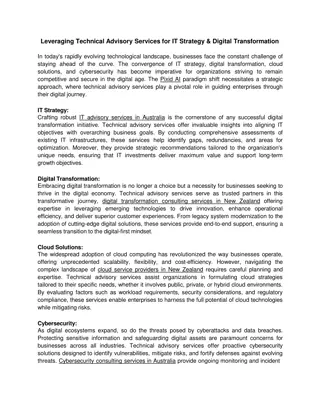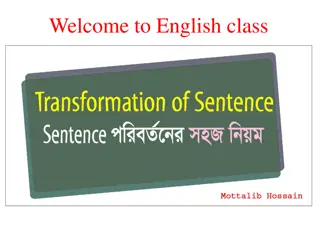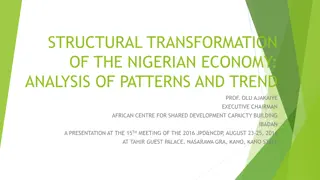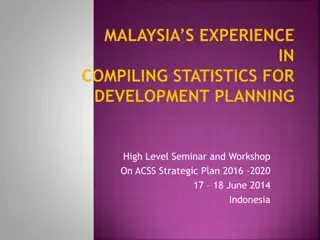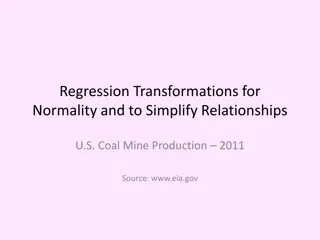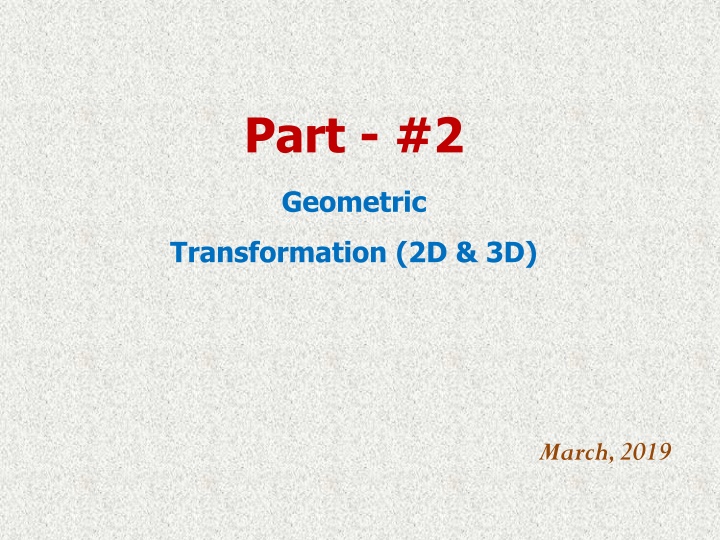
Geometric Transformation: Understanding 2D & 3D Concepts
Dive into the world of geometric transformations in computer graphics. Learn how to manipulate object shape, size, and location through translation, rotation, scaling, and more. Discover the essentials of geometric and visual transformations, along with practical examples and the use of matrices.
Download Presentation

Please find below an Image/Link to download the presentation.
The content on the website is provided AS IS for your information and personal use only. It may not be sold, licensed, or shared on other websites without obtaining consent from the author. If you encounter any issues during the download, it is possible that the publisher has removed the file from their server.
You are allowed to download the files provided on this website for personal or commercial use, subject to the condition that they are used lawfully. All files are the property of their respective owners.
The content on the website is provided AS IS for your information and personal use only. It may not be sold, licensed, or shared on other websites without obtaining consent from the author.
E N D
Presentation Transcript
Part - #2 Geometric Transformation (2D & 3D) March, 2019
1. Geometric Transformations What is transformation? > It is the backbone of computer graphics, enabling us to manipulate the shape, size, and location of the object. > Changing something to something else via rules. Why are they important to graphics? > It can be used to effect the following changes in a geometric object: 1. Change the location 2. Change the shape 3. Change the size 4. Rotate 5. Copy
2. Types of Transformations i. Geometric/Object Transformation > This transformation alters the coordinate values of the object. Basic operations are scaling, translation, rotation and combination of one or more of these basic transformations. > Object transformation = Move (transform) an object in the 2D/3D space. ii. Visual/ Coordinate System Transformation > In this transformation there is no change in either the geometry or the coordinates of the object. A copy of the object is placed at the desired sight, without changing the coordinate values of the object. > Coordinate system transformation = Move (transform) the coordinate system. View the objects from the new coordinate system.
3. Types of Geometric Transformations Translation Rotation Scaling Reflection/Mirroring. 4
i. Translation - 2D Moving an object is called a translation. We translate a point by adding to the x and y coordinates, respectively, the amount the point should be shifted in the x and y directions. We translate an object by translating each vertex in the object.
ii. Scaling > Changing the size of an object is called a scale. We scale an object by scaling the x and y coordinates of each vertex in the object.
iii. Rotation about the origin Consider rotation about the origin by degrees Radius stays the same, angle increases by .
Contd Example: Translate the rectangle (2, 2), (2, 8), (10, 8), (10, 2) 2 units along x-axis and 3 units along y-axis.
Example: If the triangle A(1, 1), B(2, 1), C(1, 3) is scaled by a factor 2, find the new coordinates of the triangle.
Contd Example: Rotate the rectangle (0, 0), (2, 0), (2, 2), (0, 2) by 30o ccw about its centroid and find the new coordinates of the rectangle.
4. Homogeneous Coordinates > In order to represent a translation as a matrix multiplication operation we use 3 x 3 matrices and pad the points to become 3 x 1 matrices. > This coordinate system (using three values to represent a 2D point) is called homogeneous coordinates. > Let the added extra coordinate be W, to a point: P (x, y, W). >Two sets of homogeneous coordinates represent the same point if they are a multiple of each other. > If W 0 , divide by it to get Cartesian coordinates of point: (x/W, y/W, 1). > If W = 0, point is said to be at infinity.
Contd Transformation matrices for 2D translation are now 3x3.
Homogeneous form of scale Concatenation of scales
Ex. 1: Rotation of object about arbitrary point P (x, y) by > Translate point (x, y) to origin by (-x, -y) > Rotate by > Translate the point by (x, y)
3 D - Rigid body transformations Methods for object modeling transformation in three dimensions are extended from two dimensional methods by including consideration for the z coordinate. Preserve lines, angles and distances. # Generalize from 2D by including z coordinate # Straight forward for translation and scale # Rotation more difficult # Homogeneous coordinates: 4 components # Transformation matrices: 4 4 l ments.
3D Point: We will consider points as column vectors. Thus, a typical point with coordinates (x, y, z) is represented as: 3D Point Homogenous Coordinate: A 3D point P is represented in homogeneous coordinates by a 4-dim, Vector. We don't lose anything. The main advantage: it is easier to compose translation and rotation. Everything is matrix multiplication.
i. 3D Translation In homogeneous coordinates, 3D transformations are represented by 4 4 matrixes:. P is translated to P' by: An object is translated in 3D dimensional by transforming each of the defining points of the objects .
Contd # An object represented as a set of polygon surfaces, is translated by translate each vertex of each surface and redraw the polygon facets in the new position.
ii. 3D Rotation In general, rotations are specified by a rotation axis and an angle. In two-dimensions there is only one choice of a rotation axis that leaves points in the plane. The easiest rotation axes are those that parallel to the coordinate axis. Positive rotation angles produce counterclockwise rotations about a coordinate axis, if we are looking along the positive half of the axis toward the coordinate origin.
Rotation about Z-axis: :For z axis same as 2D rotation: Rotation about X-axis: P = Rz( ) P P = Rx( ) P
Contd Y-axis rotation: X Y = Z 1 0 0 0 1 cos( ) 0 0 sin( ) 0 -sin( ) 0 0 cos( ) 0 1 0
General 3D Rotations about axis // to Coordinate Axis Rotation axis parallel with coordinate axis (Example x axis):
iii. 3D Scaling # About origin: changes the size of the object and repositions the object relative to the coordinate original. P = S P
iV. 3D Reflections About an axis: equivalent to 180 rotation about that axis. About a plane: A reflection through the xy plane. A reflections through the xz and the yz planes are defined similarly.
Exercise You sat in the car, and find the side mirror 40mm on your right and 30mm in your front. You started your car and drove 200mm forward, turned 30 degrees to right, moved 200mm forward again, and turned 45 degrees to the right, and stopped. What is the position of the side mirror now, relative to where you were sitting in the beginning?
Solution # The side mirror position is locally (40, 30). # The matrix of first driving forward 200mm is:
Contd The matrix to turn to the right 30 deg and 45 degrees (rotating -30 and -45 degrees about the origin) are: The 3rd transformation is moving by 200mm along an axis oriented 60 degree with the x-axis.




